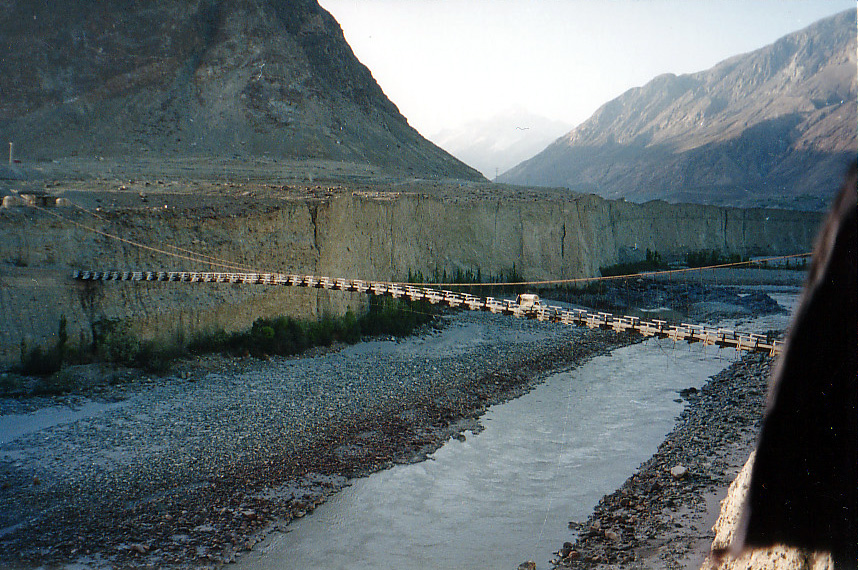The Danyore Suspension Bridge near Gilgit is one of the oldest suspension bridges in Gilgit-Baltistan, Pakistan. The 510 ft long bridge has served as a source of commute to the people otherwise had to take the local raft or a detour to travel to Gilgit city – the administrative headquarter and the capital of Gilgit-Baltistan, formerly northern areas. It is now serving as one of the major tourist attractions in Gilgit-Baltistan used only by the pedestrians and motorcyclists.
History
The construction work of the Karakoram Highway completed in 1978 while before the construction of the highway, Gilgit-Baltistan was a remote territory. Access to the region from other parts of the country was hard and the poor infrastructure within the region made things tough for the residents.
Gilgit being the headquarters and business centre attracted people from immediate and far surroundings for many reasons – education, jobs, merchandise selling, medical treatment and for other purposes. For the people settled to the immediate south of Gilgit Town otherwise separated by the Hunza River, along with the northern bank of Gilgit river, that include Danyore, Oshikhandas and Bagrot, crossing over to Gilgit was a tough job. Before installation of the local raft (Jaalo) on the Hunza River in 1945 to cross over to Gilgit, these residents would make a long detour to reach the town and that would cost almost an entire day as compared to about 15 to 20 minutes today.
The need for construction of a bridge was conceived and a hefty fund of Rs. 20,000 was generated through the contribution by the residents of Danyore and southern regions in the late 1950s. As soon as the suspension bridge was erected, it was washed away by the Hunza River being extremely low to the riverside. It was indeed a huge loss.
The location for another bridge, on a fair altitude from the river, was selected and again through the contribution of funds and donation of construction wood by each household, the construction of current suspension bridge was accomplished in 1960.
The Danyore suspension bridge has for more than five decades served as a reliable source of commute to the people travelling to Gilgit and reduced the ordeals of frequent travellers. The local raft could provide transfer only in daylight; the bridge provided a 24-hour hassle-free service and made the lives of the people easy. Its construction proved as a big relief.
Construction
The bridge was constructed by Ahmed Ali (late), well-known as “Thikedar Bereno”, a renowned constructor and self-taught engineer from Hunza who had earned name and repute for his construction expertise and projects, particularly of bridges, across Gilgit-Baltistan.
The construction of Danyore suspension bridge began in 1957 and completed by the end of 1960. Principal work included the construction of the bridge itself over the Hunza River and the annexing single lane curved tunnel to the south leading access to Danoyre which was dug by locals without proper engineering equipment.
The bridge is situated over the Hunza River almost 2 km short of its confluence with Gilgit River. It was only meant to use for mini vehicles since it was constructed until an alternate concrete bridge was built. The western end of the bridge is connected to KIU campus that further leads to Gilgit town while the eastern end is connected to a single lane tunnel in Danyore side that further meets the Karakoram Highway.
The location, length, and design of the bridge make it one of the spectacular bridges in the world. Driving on the bridge and passing through the tunnel, abruptly connecting the bridge, is quite a technical job and a test the skill and nerve of local drivers.
The bridge has been closed for conventional transportation recently and only pedestrians and motorcyclists can pass through after it was declared unsafe by local administration. For general traffic, a concrete bridge has been constructed nearby that can sustain the flow of all type of traffic.
Attraction
The Danyore Suspension Bridge was renovated in 2018 and the sections of road on both ends of the bridge have been refurbished and decorated to turn it as a tourist attraction. To the Gilgit side, there is a significant Buddhist rock carving site preserved for the visitors that further adds to the attraction of the site. The nearest attraction to the Danyore side, on the KKH, is the Chinese Graveyard which is a must visit tourist site.
The views of the bridge from both elevated sides are quite spectacular as the bridge itself has been built on a comparatively lower setting. Likewise, the views from the bridge are equally amazing. For new visitors, visiting this site is simply a memorable experience.


Comment (0)